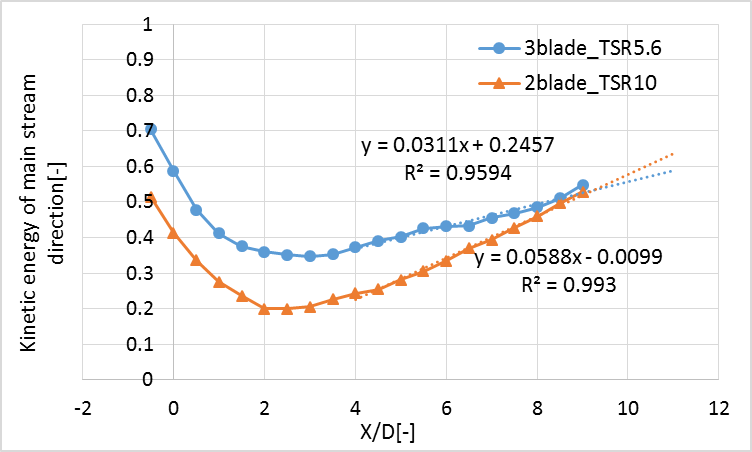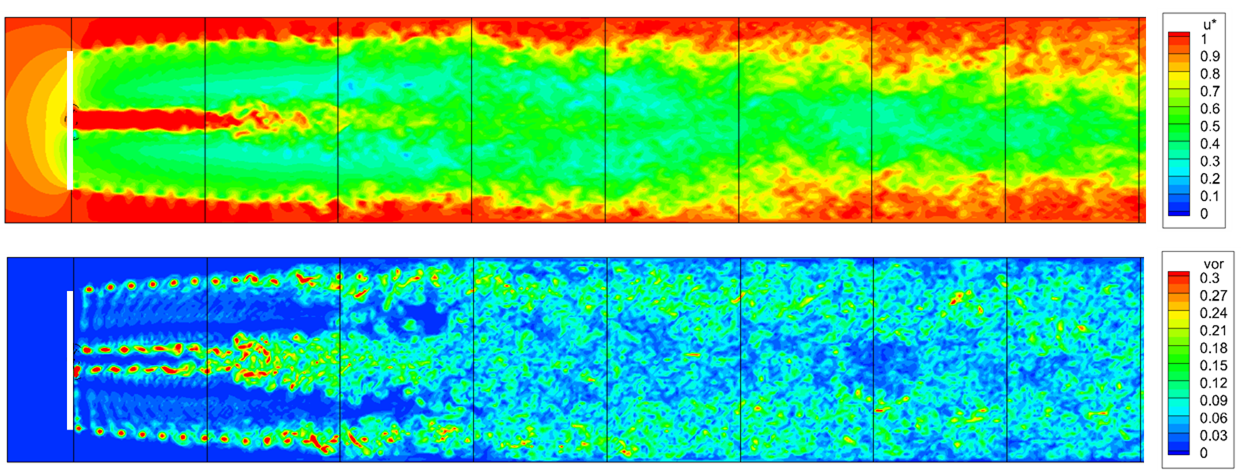CFD analysis of wind turbine wake
JAXA Supercomputer System Annual Report April 2016-March 2017
Report Number: R16E0104
- Responsible Representative: Yuichi Matsuo(Aeronautical Technology Directorate, Numerical Simulation Research Unit)
- Contact Information: Yosuke Shinozaki(shinozaki.yosuke@ilab.eco.rcast.u-tokyo.ac.jp)
- Members: Keita Kimura, Yasutada Tanabe, Yuta Uemura, Yosuke Shinozaki
- Subject Category: Aviation(other )
Abstract
In a wind farm, a distance between turbines is important from the point of view of energy recovery and turbulence intensity in a wake. And in recent years, the introduction of two-bladed wind turbines is investigated. The purpose of this study is to reveal the effect of blade number change on the wake from the wind turbines.
Goal
The purpose of this study is to investigate the effect of blade number change on a wind turbine wake for introduction of two bladed wind turbines.
Objective
The aim of this study is to reveal the effect of blade number change on a wind turbine wake (velocity profile, rate of energy recovery) by calculating wakes including tip vortexes for two and three bladed turbines.
References and Links
N/A
Use of the Supercomputer
SORA-MA and SORA-PP are used considering the scale of calculation. All cases use only one node per one case.
Necessity of the Supercomputer
Wake structure of a wind turbine changes along a distance several times of the rotor diameter. So, large scale calculation with a large calculating area can’t be avoided. Therefore, a use of super computer is needed to carry out this kind of large scale calculations.
Achievements of the Year
For two and three bladed wind turbines, calculations were performed under the same condition of the wind tunnel test. First, the results of CFD were compared with those of wind tunnel test regarding thrust coefficient (dimensionless number of thrust) are validated. Next, the case of two and three bladed wind turbine were compared under the same thrust coefficient. As a result, following fact were revealed.
1. The rate of energy recovery is influenced by the number of blades.
2. The rate of two bladed one is larger than that of three bladed.
Publications
Peer-reviewed articles
1) Keita Kimura, Yasutada Tanabe, Takashi Aoyama, Yuichi Matsuo, Chuichi Arakawa, and Makoto Iida, ‘CFD simulations of a wind turbine for analysis of tip vortex breakdown,’ Journal of Physics: Conference Series, 749 (2016) 012013, 2016
Presentations
1) Keita Kimura, Yasutada Tanabe, Takashi Aoyama, Yuichi Matsuo, Chuichi Arakawa, and Makoto Iida, ‘CFD simulations of a wind turbine for analysis of tip vortex breakdown,’ WindEUROPE SUMMIT 2016, Hamburg, Germany, September, 2016
2) Keita Kimura, Yasutada Tanabe, Takashi Aoyama, Yuichi Matsuo, Chuichi Arakawa, and Makoto Iida, ‘Evaluation of wind turbine wake simulation focusing on grid resolution,’ WWEC 2016, Tokyo, Japan, October, 2016
Computational Information
- Parallelization Methods: Thread Parallelization
- Process Parallelization Methods: n/a
- Thread Parallelization Methods: OpenMP
- Number of Processes: 1
- Number of Threads per Process: 32
- Number of Nodes Used: 1
- Elapsed Time per Case (Hours): 3000
- Number of Cases: 10
Resources Used
Total Amount of Virtual Cost(Yen): 4,527,094
Breakdown List by Resources
| System Name | Amount of Core Time(core x hours) | Virtual Cost(Yen) |
|---|---|---|
| SORA-MA | 1,113,841.57 | 1,831,990 |
| SORA-PP | 233,201.66 | 1,991,075 |
| SORA-LM | 9,573.84 | 215,411 |
| SORA-TPP | 0.00 | 0 |
| File System Name | Storage assigned(GiB) | Virtual Cost(Yen) |
|---|---|---|
| /home | 174.05 | 1,641 |
| /data | 41,370.41 | 390,248 |
| /ltmp | 10,253.91 | 96,725 |
| Archiving System Name | Storage used(TiB) | Virtual Cost(Yen) |
|---|---|---|
| J-SPACE | 0.00 | 0 |
Note: Virtual Cost=amount of cost, using the unit price list of JAXA Facility Utilization program(2016)
JAXA Supercomputer System Annual Report April 2016-March 2017




